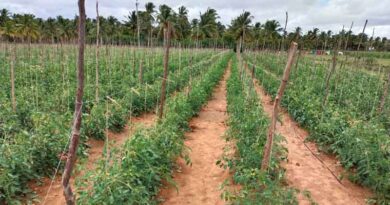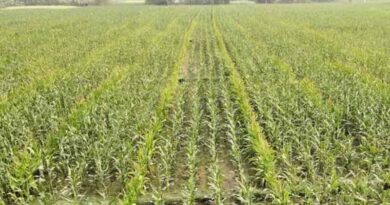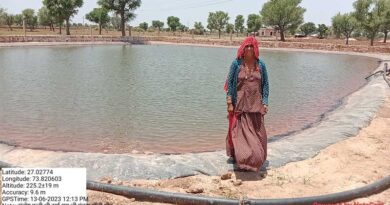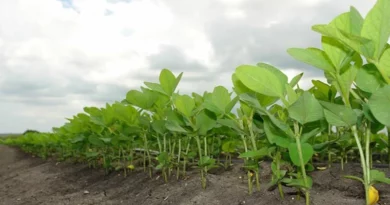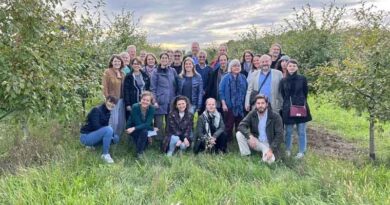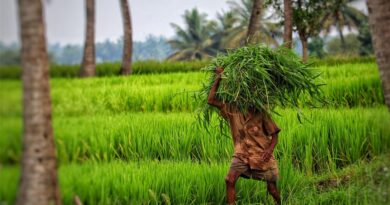Farm Ponds: A reliable water source in the rain-fed region of Champawat
29 September 2023, New Delhi: Jeevanti Devi, a resident of Talla Bapru village, Champawat, Uttarakhand, shared the problem of water scarcity and how it affected their agriculture practices. Her family solely depends on agriculture for livelihood, with an annual income of INR 40,000 to 50,000 from growing vegetables such as brinjal, potato, chilly, pea, pulses, and wheat. The region’s primary season for rain-fed crop cultivation is April to July.
Jeevanti’s family had no water irrigation source and depended only on rainfall. Her family has one acre of land, out of which only 50 percent of the land is cultivated, and more than 80 percent of their cultivated land is rain-fed. They cannot expand their developed area due to water scarcity, as the perennial water source is around 300 meters away from their agricultural field, and no other source of irrigation is available.
She joined the Farmer Interest Group (FIG), created by the S M Sehgal Foundation in Talla Bapru village under the Focus Development Program supported by HDFC Bank’s Parivartan project, to explore different sources of irrigation.
Jeevanti was a regular attendee in all training and capacity-building sessions on several topics. In one of the meetings, she shared that her husband, Pushkar Singh, lost his job during the pandemic and had to resort to labor work with MNREGA. Farming has been their only source of livelihood since then. Understanding her need, the group decided to construct a farm pond for irrigation on her cultivated land. The pond was built with a capacity of almost 10,500 liters in her field under the supervision of the Sehgal Foundation team and the shramdaan (voluntary labor) from the beneficiary group.
Farm ponds are artificial water reservoirs constructed in farmlands to provide a reliable water source for irrigation and other agricultural purposes. They are typically built by excavating the ground and lining it with an impermeable material like plastic (300 gsm) over the cow dung and clay layer to prevent water seepage. The size of the farm pond can vary depending on the farmer’s needs and the land’s topography in hilly terrain areas.
Farm ponds help farmers to overcome the problem of water scarcity and reduce their dependence on rain-fed agriculture. They can store rainwater during the monsoon season or through perennial natural streams to provide a reliable water source for irrigation during the dry season. This helps farmers grow crops yearly, increases crop yield, and diversifies their crop portfolio.
Most farmers in Champawat grow horticulture crops only in the kharif season. With the availability of farm ponds, farmers can harness water resources from springs to produce a variety of horticulture crops. During the monsoon season, the rainwater collected in the tank can be used for irrigation in the subsequent dry season months. Now with the availability of a water tank, Jeevanti’s family has started farming near the tank site, which had been previously abandoned due to a lack of irrigation facilities. They also supply water to the neighboring farmers whose fields are adjacent to the tank.
Another tank with a storage capacity of 10,000 liters of natural water was constructed on Laxmi Devi’s land in the village of Sipti, which would help irrigate 10–15 nalis (about 0.5 acres). At least six families from the village will benefit, and the farmers can earn profit by cultivating different crops, including multiple vegetable crops, on their land.
Bhawan Singh, a forty-eight-year-old resident of the village of Tallichanda, supports his family through agriculture on his two-acre land, animal husbandry, and daily wage work. He was a prosperous farmer, but with climate change, natural water sources started drying up; he had no option but to rely on the remaining 4-5 nalis (0.24 acres) for cultivation. The limited means of employment drove his sons to migrate for work. However, under the HDFC Parivartan project, building a pond was proposed for water storage, giving Bhawan Singh hope and relief. Since the completion of the farm pond, he has planted wheat, onion, and mustard crops, with a big smile on his face.
In another village of Pau, situated about 10 km from the Lohaghat block of Champawat district, farmer Keshav Dutt has been able to put his entire farmland of 10 nalis (0.5 acres) under cultivation because of the newly constructed farm pond. In just six months, he has seen a considerable income increase, including vegetable crops with wheat in his field.
The Focused Development Program, through the intervention of farm ponds, has provided an opportunity to cultivate more horticulture crops in the barren agricultural land of several farmers and has enabled them to improve their family income without abandoning agriculture.
Also Read: More Power. More Intelligence. New Holland presents the new T7.340 HD with PLM Intelligence
(For Latest Agriculture News & Updates, follow Krishak Jagat on Google News)




